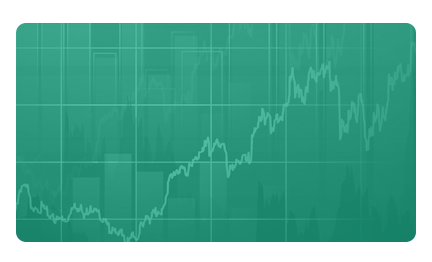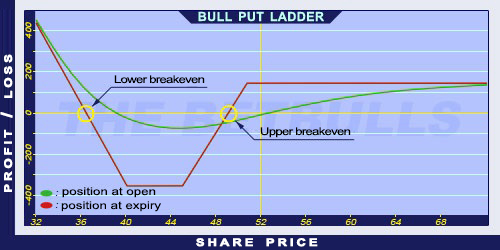Description and use
Bull Put Ladder is a version of Bull Put Spread, but there is an extra Long Put involved with a lower strike price. When share prices fall, the potential profit will be unlimited. It is a spread strategy, because it consists of a Long and a Short position in the same time. It is also a vertical strategy, because the two positions have different strike prices. The investor speculates on decreasing market prices. This strategy should be used when the trader is not totally sure about the decreasing direction of the market. The strategy usually is a net debit investment, but credit version is also popular. The direction of the market is decreasing. When the share price is below the lower strike price (Long), the position will be potentially unlimited profitmaking until the share price reaches zero. The loss can be maximised when the share price is between the higher and the middle strike prices. Because of the extra component, there are both lower and Upper breakeven points. The investment is medium-term. Then, there will be enough time for the underlying product to move the profitable direction and the time not to have a negative effect on the Long option.
- Type: Bearish
- Transaction type: Credit
- Maximum profit: Limited
- Maximum loss: Limited
- Strategy: Vertical spread
Opening the position
- Purchase lower strike Put options.
- Purchase a middle-strike Put option (same quantity and expiration as the other Put options’).
- Sell high-strike Put options (same quantity and expiration as the other Put options’).
Steps
Entry:
- Make sure the trend is going in the expected direction.
Exit:
- Close the positions at least one month before the expiry date.
Basic characteristics
Maximum loss: Limited. Middle strike price - Higher strike price + Net debit.
Temporary loss: Net debit.
Maximum profit: Unlimited.
Time decay: Time decay has a positive effect on the value if the share price is around the lower strike price. This positive effect is enhanced if the share price is around the higher strike price.
Lower breakeven point: Lower strike price - Maximum loss.
Upper breakeven point: Higher strike + Net debit (or - Net credit).
Advantages and disadvantages
Advantages:
- Unlimited potential profit.
- Limited loss.
Disadvantages:
- Can be a net debit investment.
- The strategy is uncertain.
Closing the position
Closing the position:
- Buy back the Short options and sell the Long options.
Mitigation of losses:
- Close the position the above-mentioned way.
Example
ABCD is traded for $52.00 on 15.05.2017. The investor buys a Long Put option which has a strike price of $40.00, expires in August 2017. and costs $1.20 (premium). Then he buys another Long Put option which has a strike price of $45.00, expires in August 2017. and costs $2.40 (premium). Then sells a Short Put option which has a strike price of $50.00, expires in August 2017. and costs $4.60 (premium).
Price of the underlying (share price): S= $52.00
Premium (Long Put 1): LP1= $1.20
Premium (Long Put 2): LP2= $2.40
Premium (Short Put): SP= $4.60
Strike price (Long Put 1): KL1= $40.00
Strike price (Long Put 2): KL2= $45.00
Strike price (Short Put): KS= $50.00
Net credit: NCr
Maximum loss: R
Maximum profit: Pr
Lower breakeven point: LBEP
Upper breakeven point: UBEP
Net credit: NCr = SP - (LP1 - LP2)
Maximum loss (risk): R = KS + KL2 - NCr (or + NCr)
Maximum profit: Pr = KL1 - R
Lower breakeven point: LBEP = KL1 - R
Upper breakeven point: UBEP = KS - NCr (or + NCr)
NCr = $1.00
R = $4.00
Pr = $36.00
LBEP = $36.00
UBEP = $49.00














